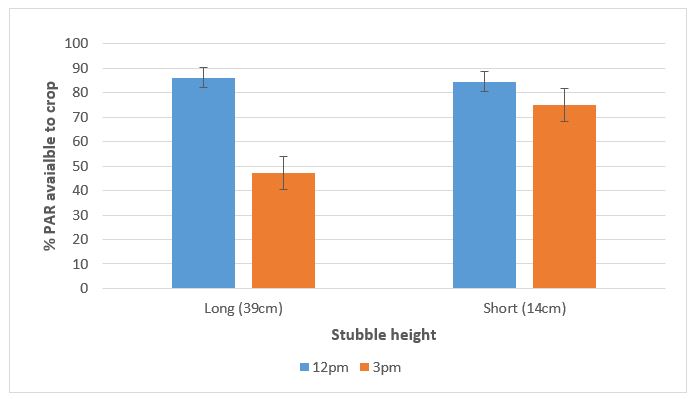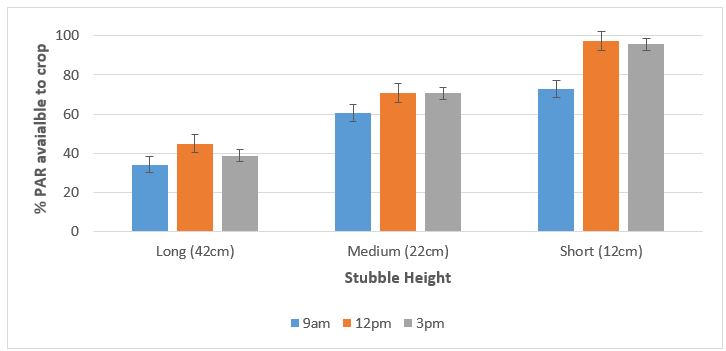Sowing into stubble — impacts of row spacing, yellow leaf spot and stubble height on crop development
Author: Nick Poole, Tracey Wylie and Michael Straight (FAR Australia) | Date: 26 Feb 2019
Take home messages
- Research results from the GRDC Stubbles Initiative and the preceding GRDC Water Use Efficiency (WUE) project have discovered several management challenges in a no-till environment where stubble loads often exceed 8t/ha.
- Triazole fungicides give relatively poor control (25%-50%) of yellow leaf spot, Pyrenophora tritici-repentis, in a wheat-on-wheat scenario, whereas variety choice and cultural practice can give up to 90% disease control.
- In comparison to the row spacing research in the GRDC WUE project (sown in late May/June), where yield decreased as row spacing increased, wheat sown in mid-April showed no negative effects of wider row spacing.
- Increasing row spacing in mid-April sown wheat had little effect on crop structure but did in some cases decrease dry matter (DM) production.
- Long stubble can have a negative effect on tiller number, DM and light interception of wheat, and in some cases cause a decrease in final grain yield.
- An increase of up to 50% photosynthetically active radiation (PAR) has been recorded in the winter months when stubble height was decreased from 42cm to 12cm.
Background
It is widely accepted that as rainfall increases across agroecological regions, the amount of full stubble retention practised in the farming system decreases. This is often because growers perceive that growing high yielding crops in stubble retained systems is more difficult than growing them in paddocks where the previous crop residue has been removed (mainly through burning). It is also true to say that much agronomic knowledge has been gleaned from trials that have not been carried out under modern no-till stubble retained (NTSR) systems, leaving a potential knowledge gap. This GRDC supported, locally specific research sought to maintain profitability of NTSR systems in medium-high rainfall environments. The project also built on findings from the previous GRDC supported WUE project.
Research
The research component of the GRDC supported project ‘Maintaining profitable farming systems with retained stubble in the Riverine Plains region’ was comprised of a series of large and small plot trials. The first of these trials was established during 2014.
Using large scale trials (focus farms), the research team evaluated the impact of a single-year, one-off change in stubble management. The results of these trials helped to determine if periodic active management of stubble in an NTSR system increases the sustainability and profitability of the system across the rotation. As different stubble management approaches are likely to perform better under different seasonal conditions, the four years of trials (2014-2017) have provided information on crop performance under a range of seasonal climatic conditions.
The focus farm trials were located at Henty and Coreen, New South Wales (NSW), and Yarrawonga and Dookie, Victoria. The rotation position was maintained by moving the trial sites around the farm to maintain either a wheat-on-wheat or wheat on canola stubble position.
Yellow leaf spot (Pyrenophora tritici-repentis)
Yellow leaf spot (YLS), caused by the fungal pathogen Pyrenophora tritici-repentis has been the principal disease, causing green leaf loss, with the most severe infection noted during 2016. Six research trials run over four years using susceptible and moderately susceptible wheat varieties, investigated this disease in a wheat-on-wheat situation.
The influence of fungicide treatment against this disease was consistent over the four years of research. Using either Prosaro® (210 g ai/L tebuconazole + 210 g ai/l prothioconazole) or Tilt® (250 g ai/L propiconazole) applied at the end of tillering/early stem elongation (GS23-33)#, disease control rarely exceeded 50% and ranged from 25 to 50% (Figure 1). This level of disease control is poor, relative to traditional control levels observed with fungicides against other diseases such as stripe rust. Despite this, there were small, but consistent, yield benefits across the four years (maximum response to fungicide during 2013 was 0.25t/ha, during 2014 was 0.21t/ha, during 2015 was 0.4t/ha and during 2016 was 0.17t/ha). These small yield effects were seen in response to two applications of fungicide and later spray timings during stem elongation, or third node (GS33).
#application earlier than label recommendation of 70% flag leaf emergence and early flowering
Foliar fungicides applied at early stem elongation (GS31) during 2014-2016 gave poor disease control and were rarely, if ever, economic. Across all four years, even though the rotation position and variety have favoured the disease, the yields of the trials was still in the 2-4t/ha range. The early infection of YLS up to GS30 (start of stem elongation) was better controlled with stubble management practices, such as burning, rather than with foliar fungicides. It was also noticeable that in the large block stubble management trials, a switch to the more resistant variety Corack gave good control of YLS, such that differences in YLS control as a result of stubble management treatment was not observed.
Figure 1. Interaction between fungicide application timing and fungicide product on YLS severity (flag-1), assessed at start of flowering (GS61), 14 October 2016
*error bars are a measure of LSD
Row spacing
Early sown row spacing trials (mid-April) at Yarrawonga ran for three years in different paddocks in the same rotation position after canola. In both 2014 and 2015, the narrow row spaced crops produced more DM, but showed no differences in grain yields (Figure 2). With higher rainfall and higher yields overall in 2016, wider row spacing (37.5cm) produced lower yields (0.34-0.43t/ha less) than the 22.5cm and 30cm row spacing.
In previous work carried out by Riverine Plains Inc. and the Foundation for Arable Research (FAR) Australia, the influence of row spacing on grain yields was shown to be affected by the overall yield potential of the season. This research showed comparable yields across row spacing under lower yielding scenarios and an advantage to narrower rows under higher yields. At a yield potential of 3.0-6.0t/ha, there was no difference in yield between 22.5cm and 30cm row spacing when wheat crops were sown in mid-April. Wheat crops sown on a 37.5cm row spacing at the same time show no yield disadvantage, provided grain yields are less than 3.5t/ha. In a dryer warmer finish to the season, a higher harvest index in the wider rows helped to compensate any yield penalty as more grain is produced from the final DM.
Results in early sown crops differ from the results generated in later sown crops (late May/early June) studied as part of the WUE project, where the 22.5cm spacing produced more DM than the 30cm spacing, which led to a higher yield. With mid-April sowing, the results demonstrated that there was no difference in yield between row spacing of 22.5cm or 30cm.
Figure 2. Influence of row spacing on grain yield in early sown wheat following canola (average of four varieties) in 2014, 2015 and 2016 (Yarrawonga, Victoria).
*error bars are a measure of LSD
Stubble height
During the four seasons (2014–2017), one of the most consistent effects of the stubble management treatments in NTSR systems was the influence of stubble length on DM production. There was a consistent reduction in tillering and DM production in longer stubble, although the effect on final grain yield was inconsistent. In 2014 at Dookie, a reduction in stubble height of 25cm significantly increased grain yield by 0.7t/ha, the largest yield effect observed in the stubble management project in the Riverine Plains. In part, this appears to be linked with nitrogen (N) availability and temperature, but these factors did not completely explain the increase in yield. In 2016 for the first time, the research team looked at differences in light interception by the growing crop canopy — more accurately described as photosynthetically active radiation (PAR). During the winter month of June 2017, the influence of the different stubble management treatments on PAR was assessed.
At Yarrawonga, results revealed reductions in PAR of approx. 50% in long stubble NTSR compared with short stubble NTSR when measurements were made at 3pm in the afternoon. However, there was no difference in PAR when treatments were compared at 12 midday (Figure 3). Although the PAR will be influenced by the sun’s zenith (high point in the sky) and row direction, the results clearly show that the ability of the crop to capture available sunlight is a key difference between crops sown into long or short stubble, and could be the major factor why there was reduced tillering and a lag in DM production associated with long stubble.
Figure 3. Influence of stubble treatment on availability of PAR at 12pm on 20 June 2017 (GS22) and 3pm on 28 June 2016 (GS23) at the Yarrawonga trial site.
*error bars are a measure of LSD
A trial at Rennie (NSW) was established in 2017 to understand the interactions of stubble height with temperature and PAR. The assessments of available PAR indicated that stubble height had a very significant influence on the % light intercepted by the crop. Crop in the long stubble (42cm) received more than half the PAR compared to short stubble (12cm) (Figure 4). The orientation of stubble rows was east-west and the differences were similar irrespective of whether comparisons were made at 9am, 12 noon or 3pm.
Figure 4. Influence of stubble height on availability of PAR at 9am on 6 June 2017, 12pm on 13 June 2017 and 3pm on 19 June 2017 at Rennie, NSW.
*error bars are a measure of LSD
Conclusion
In conclusion, the GRDC Stubbles Initiative research trials in the Riverine Plains region have enabled growers to better understand and mitigate the management issues around crop development in a no-till system. Effects of disease, in this case YLS, in tight wheat no-till rotations can be mitigated by an integrated approach using cultural methods, by removing/reducing stubble, selecting resistant varieties and applying fungicide when necessary at the start of stem elongation. When planting wheat in mid-April, row spacing in the 22.5-37.5cm range has less effect on final grain yield. In a no-till system, wider rows allow for better trash flow in high stubble loads at sowing time. Stubble height of the previous crop has a profound effect on crop development, especially early in the growth stage. Longer stubble (>30cm) reduced tiller numbers and DM over four years of research, due to shading and significantly reduced grain yield, in one trial, when compared to short stubble (<15cm).
Acknowledgements
The research undertaken as part of the project ‘Maintaining profitable farming systems with retained stubble in the Riverine Plains region’ was made possible by the significant contributions of growers through both trial co-operation and the support of the GRDC. FAR Australia would like to thank them for their continued support.
FAR Australia also thanks the Riverine Plains farming group, particularly research officer Cassandra Schefe and the members who hosted trials, for their support and co-operation in the project.
Contact details
Michael Straight
FAR Australia
Shop 4, 97-103 Melbourne Street, Mulwala, NSW 2647
0427142033
michael.straight@faraustralia.com.au
@straight_mp
Was this page helpful?
YOUR FEEDBACK




